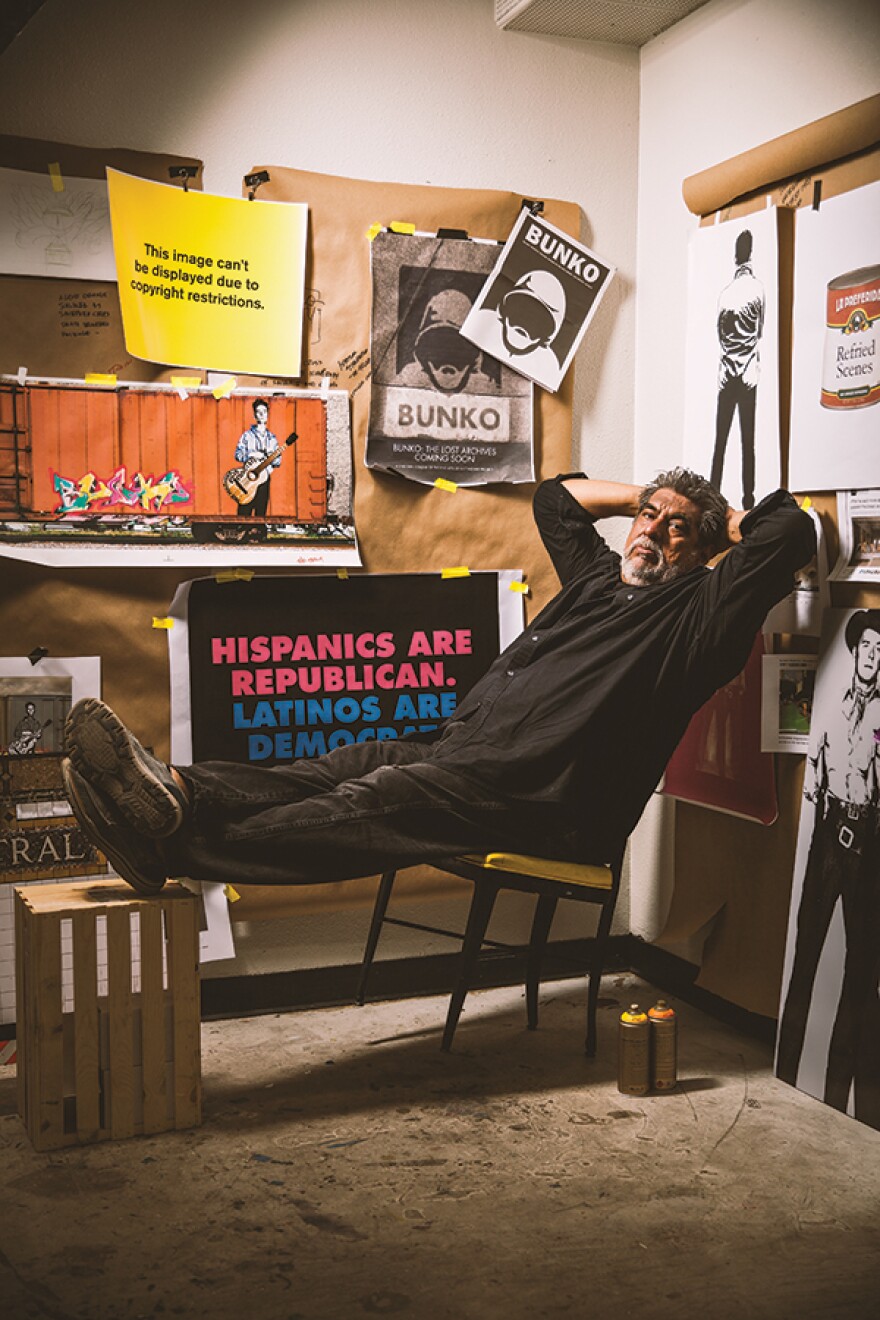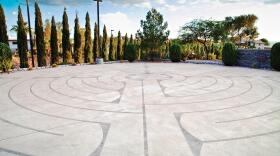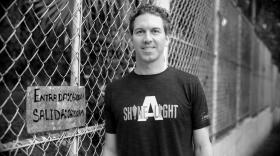What’s real anymore? Or, more profoundly, who’s real anymore? Tesla brainiac Elon Musk thinks we’re probably characters in a vast computer simulation (there’s “a billion to one chance we’re living in base reality”). Meanwhile, nearly everyone tied to the election — parties, PACs, media — continually spams a dazed America with distorted representations of one candidate or another. The existence of a “base reality” seems more debatable every day.
Into this topsy-truthy era comes Bunko, a forgotten underground street artist. He’s known only through materials discovered at a North Las Vegas garage sale by Ed Fuentes, a local arts writer. “I found four boxes,” Fuentes told us. “The person who had them said, ‘My wife buys a lot of crap.’” The first exhibit of Bunko materials, curated by Fuentes and spanning the mid-Reagan years to the advent of George W. Bush, just closed at UNLV. What makes Bunko ideal for our reality-warping moment is that he and his work are also entirely fictional — tailored to be ideal for our moment by Ed Fuentes, UNLV MFA candidate. Bunko is his “midway” program: the fake artist as real art.
***
Ed Fuentes himself is more or less real, or at least he was when we saw him the other day: 55, bearded, fleshy, garrulous, expansive of personality, approximately 3 percent larger than life. Arriving here from Los Angeles in 2012, Fuentes quickly became a key chronicler and evangelizer of the arts scene. Someone hangs a painting in this joint, Ed’s there, writing it up on his blog, Paint This Desert, pushing it out on social media. “His blog is really quite wonderful,” says Patrick Gaffey, a cultural supervisor with Clark County. “Someone coming from L.A. might assume there’s nothing worth writing about here. But there is, and he sniffed it out.” Fuentes launched his site with a big Warhol Foundation grant in 2013, and received a state arts council grant last year. “He’s a great cheerleader,” Gaffey says.
Fuentes’ time here has coincided with the boom in Downtown murals and street art, genres he’d covered in Los Angeles, making him the go-to explainer for the movement in Las Vegas. (He had a natural fluency with the forms after a barrio childhood in Riverside, California, where Chicano-heritage murals were “part of your DNA.”) He’s a bit of a Swiss Army knife: writer, graphic designer (for Variety and NBC), photographer, quote machine, idea-generator (it was he who nudged Clark County to create its successful poet laureate program). Now he’s girding all that with a midlife master’s degree.
[[field:story]]
“I don’t look at it as, This will help me get a job later,” he said. “It’s just a good way to take all the work that I’ve done for 15 years, find a new context for it and make it mean something more for me, and maybe lead to something else.”
***
So, about this artist, Bunko. “The guy’s pretty good!” his creator said, in mirthful repose on a couch in the lobby of UNLV’s Barrick Museum, where he was killing time that day. Bunko’s work is sly and political, tinctured with Chicano advocacy. One wry bit of type art, “CH iCANO” — with the middle of the word highlighted as a Latino empowerment message — was, according to Bunko’s “story,” thwarted when Apple debuted its own lowercase-I logo, for the iPod, before Bunko could get his up on a wall. “Mac beat me to the street,” Bunko wrote in his notebook. Other pieces mix media criticism, Reagan mythology and art history; Fuentes worked hard to make it all look like products of 1990s technology.
Bunko — the artist, the idea, the exhibit — is high-concept simulacra, carefully scripted counterfeit realities designed to elicit a specific response ... just like so much of Las Vegas and, here comes the bitter joke, our politics, too. Both have, shall we say, a loose tether on base reality. “It’s a Las Vegas show because you’re talking about a false environment,” he says, meaning the UNLV gallery brimming with themed falsehoods. And it’s a political show, because, well: “As you can see by this election, and by this show, you can make facts an abstract idea — which is the whole point of this show,” Fuentes says. “You have to know your facts. That’s the burden we all have.”
***
Angling for a quotable takeaway, we press Fuentes on a final point: Given the ominous crescendos of the election and what will surely be its contentious aftermath, what is the point of art amid the high-stakes craziness?
He paused a moment, perhaps considering the lessons of an exhibit about the permeable membrane between fact and fiction, an ambiguity many are content to ignore and others are determined to monetize. “I think art can help you define the questions,” he said at last. “That’s its role. Then you can start finding answers.” Finding answers: That may be the real billion-to-one shot.








